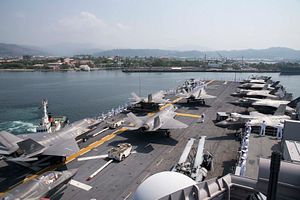Earlier this week, as the United States and the Philippines continue to sort out an alliance crisis sparked by President Rodrigo Duterte’s request to terminate the Visiting Forces Agreement (VFA), the Philippines disclosed more details about an upcoming iteration of the largest military exercise between the two countries. While the details remain quite limited, they nonetheless provide more clarity about the shape of the next iteration of drills and what they signify for the defense aspect of the relationship.
As I have observed before in these pages, Duterte’s request to terminate the VFA has raised broader questions about its strategic significance for the alliance as well as the operational consequences for what the two countries can do in the coming months during the 180-day period where they continue to be in talks to sort this out. Of particular focus has been the Balikatan exercises, which have traditionally been the largest bilateral drills between the two countries and had been slated to occur later this year.
Back in February, Lorenzana had suggested in general that 2020 planned military exercises and engagements – numbering over 300 this year, an increase from 2019 – would proceed as scheduled during this period since the VFA would remain in force, even though the United States may opt to discontinue the scheduled exercises before the 180 days are up. But no further specifics had been unveiled about particular drills, including Balikatan.
This week, we received more details about the status of the Balikatan exercises scheduled for May. The details were disclosed by Armed Forces of the Philippines (AFP) spokesperson Edgard Arevalo at a press briefing that was held on March 3.
Per Arevalo, the exercises, currently set to push ahead as scheduled, are expected to involve 6,529 Americans, 4,302 Filipinos, and 44 Australians. He added that there had been no changes in the original plans in terms of the number of attendees and participants.
Arevalo also indicated that the lead up to the exercise would play out as expected as well. According to his comments, some personnel would start arriving next month to prepare the supplies, medical requirements, and other logistics ahead of the arrival of the main contingent in May.
While Arevalo’s comments themselves are not surprising and are in line with what Philippine officials including Lorenzana had mentioned before, they are not without significance. If things play out as Arevalo suggests, the 2020 Balikatan exercises would be the largest iteration of the drills held under Duterte’s tenure despite his attempts to scrap it at the outset – a powerful demonstration of the resilience of the alliance. Indeed, for a larger contingent than the one planned for 2020, one has to go back to 2015, when the United States and the Philippines were governed by U.S. President Barack Obama and Benigno Aquino III respectively.
To be sure, Arevalo’s comments do still leave a number of lingering questions about the shape of the Balikatan exercises, including the exact engagements that would be carried out, the functional areas of focus, if there would be any notable firsts in the drills relative to previous years, and how any broader VFA talks may affect specific engagements. As we get closer to the drills, those specifics will continue to be important to watch out for as we attempt to get a better sense of how Balikatan plays out and what it means for the alliance.

































